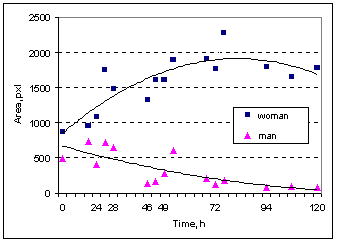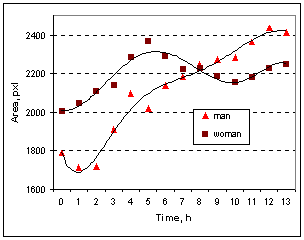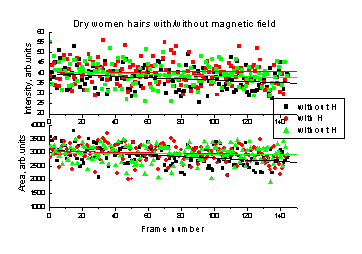

|
метод ГРВ профессора К.Г. Короткова |
|||||||||
|---|---|---|---|---|---|---|---|---|---|
Vainshelboim A. *, Korotkov K. **, Shigalev V. ***, Beljakov V. *** , Korenugin D.G. ***
Part 3. Time DEPENDENCE OF GDV PARAMETERS OF human hair AND Effect S of ELECTROMAGNETIC FIELDS TO THIS PROCESS
*Aveda Corporation, Blaine, Minnesota USA; ** State University SPITMO, St. Petersburg, Russia; *** State Politechnical University, St. Petersburg, Russia.
However, the hair swatches showed no significant decline in activity, as opposed to that shown by the samples from live subjects.
Results and Discussion
Experiment Introduction
In this paper, third in the series presented in the issue, we demonstrate results of time dependence of GDV response in both dry and fresh human hair.
Experiment 2
Experimental results
The most interesting data was found for the time dependence of hair gas discharge parameters. While for metal cylinder and dried hair neither intensity nor area of the image changed over time, for fresh hair these parameters GDV parameters had different behavior for different subjects. Let us discuss the main features on the example of woman's and man's hair GDV parameters taken at constant humidity during 5 days (at day-time only) and during 13 hours every other hour Ц fig. 1.
• Immediately after cutting and in the first day parameters practically did not change.
• GDV measures are very consistent when measured in short-time interval (10-60 seconds in-between measures).
• In the 2 nd , 3 rd and 4 th days GDV Area increased during the day with 2 hours intervals between the measures.
• This day increase was presented at women's measurements for the first 3 days and at man's measurements for the first 2 days.
• After 10 hours night break the value of the GDV Area was dropping down.
• For all measured women an overall decrease of GDV parameters in 5 days was presented. The level of decrease from the moment of cut was different for different subjects but this effect was reproducible in numerous experiments conducted independently both in the USA and Russia . After several days of oscillations both Area and Intensity of the images gradually dropped down to relatively stable level.
• For a man GDV parameters decreased practically to zero in a 5 days. There was a big difference between women's and man's hair GDV parameters; note that these hair had different structure and hairbreadth.
• Very similar behavior has other GDV parameters.
• Detailed measurements conducted every hour revealed oscillation behavior of the parameters. These oscillations may explain abovementioned features of day-to-day behavior but there biophysical nature still needs explanation. We pay attention that measurements were conducted during 24 hours immediately after hair cut from the head.


Fig. 1. Long-term and short-term time dependence of the Area of gas discharge images of swatch of fresh human hair for a woman and a man.
Influence of magnetic and electrical fields to human hair.
Stage 1. Testing with metal uncoated wire. A model of swatch from the metal uncoated wire was developed. This model was installed into the GDV Camera and GDV parameters were measured in the same regimes as used for hair. Application of a constant magnetic field (ferrite), electrical field and chemicals to this wire had no effect on the GDV parameters.
Stage 2. Testing of freshly cut and dried hair. Swatch of freshly cut hair of a healthy yang woman and man or a swatch of dried hair from AVEDA samples was installed in the GDV Camera. To the edge 2 of a swatch the following influence was applied:
• Magnetic field from the ferrite magnet not touching the hair;
• Electrical field from two parallel electrodes not touching the hair .
Fig.2 presents results of magnetic field application. As we see from the graphs there was significant influence of the magnetic field to the fresh hair and no effect for the dry hair (as well as for metal wires). Effect was reversible and reproducible, statistically significant (p < 0.001). No after-effects were found. This shift was about 10%. Other GDV parameters did not demonstrate any effects of EMF. As we see from the graphs, the dispersion of data for the fresh and dry hair was dramatically different. Same effect, but with increase of intensity, was found for the electrical field. The shift for the fresh hair was about 40%.
|

Fig.2. Time series of GDV parameters under the influence of magnetic field for fresh and dry woman's hair. The abscissa axis presents the number of a BMP image in a series of AVI file. Dots Ц initial measurement, circles Ц magnetic field on, triangles Ц magnetic field off.
Conclusions
• While further investigation of this phenomenon is needed, this disruption was not dependent on the gross physical characteristics of the freshly cut samples; nor was it observed on the dried single-sourced hair. These results support the hypothesis of the transmission of signals between human hair and body due to the electron jumping with tunneling mechanism, possibly centered on the polypeptide composition of hair. Hair cuticles comprise specific amino acids, notably cysteine, serine, and glutamic acid.
• GDV presents a highly sensitive and reproducible technique for the testing of human hair. It was able to record specific properties of freshly cut hair that are not observed in dried samples. This approach may be used for the study of influence of different treatments like coloring, washing, drying to the human hair.
Acknoledgments. We would like to thank E. Kriganovski, M. Babitski and D. Muromtsev for creating software, R. Usubov for development of equipment, and J. Dachtera, J. Jasperson, L. Geisbauer, M. Hayes and J. Chapman for their assistance with the experiments and preparing materials.
Protasevich ET. Cold non-equilibrum plasma. Cambridge: Cambridge International Sci entific Publishing. 1999. The capacity for human hair to carry significant static electrical charges is well known. Many children have been shown the traditional displays at the local science museum Ц a balloon, after being rubbed against the head, sticks to the wall; a comb, after being passed through the hair, picks up confetti; a VanDeGraaf generator makes the hair stand on end. These effects depend on the hair, and the surrounding air, to be fairly dry. This allows various materials to strip the electrons from the hair surface, creating a strong positive charge.
But even damp hair is a electrically active system. Hair is traditionally been considered a Сdead' tissue, but when attached to the body exhibits considerable electrochemical activity. The surface of the hair shaft has a molecular structure that attracts water molecules from the atmosphere. These water molecules, prevalent at all but the driest conditions, allow for the passage of pi, or unbonded, electrons across the hair surface.
Certain laboratory tests can detect the activity of these electrons, including GDV [Gas Discharge Visualization], or corona discharge photography. This technology developed from the Kirlian effect, a phenomenon in which organic materials subjected to a strong electromagnetic field exhibit a glowing corona around their margins. This corona is caused by electron УavalancheФ collisions in the charged environment in the testing apparatus.
Experiments with Kirlian photography, from the earliest stages of its development, have shown curious effects from organic samples tested before and after mechanical separation from the organism. Most notably, leaves that have been plucked from a living plant and then cut into two pieces retain traces of the biological activity in their vein structure. More recently, researchers have sought to explore the changes in the corona discharge effect over time, using the technique of УDynamic GDV [Gas Discharge Visualization].Ф This technique uses video to record the effect of the EMF on the sample material. The resulting video footage is then statistically analyzed to quantify size, shape and brightness of the corona effect. In testing the electric activity in human hair, the brightness, or intensity, of the hair's discharge was used as the scale on which activity was determined.
It was discovered that many different materials, including human tissues, show a continued level of activity after separation. In the case of human hair, this activity remains at a steady level for approximately 24 hours, after which it slowly declines. After seven days, the activity appears to slow to the level exhibited by control samples Ц human hair that has been separate from its donor for several weeks.
Assuming that the activity depicted by the GDV technique is indeed electron transport across the surface of the hair, we would expect this activity to increase as humidity levels rose. Studies on electromagnetic field perception have shown that the dielectric constant of hair, relatively stable at Rh levels of 30 Ц 60 percent, the normal ambient range for most buildings and other controlled environments, increases by a factor of nearly ten times when humidity rises from 70 to 90 percent [Odagiri et. Al. 1994] This effect on the dielectric constant, a major determinant of the static charge capacity of materials, means that hair as a conveyor of static charges actually becomes more efficient as humidity levels rise.
By the same token, the dielectric constant is not affected strongly by the ambient temperature of a room. In the aforementioned study, the dielectric constant remained effectively steady through a temperature range of 15 to 30 degrees centigrade.
Assuming that the secondary-bond water theory is correct, dramatically lessened activity should be seen in hair under a 0% Rh environment and inert atmosphere (preventing re-uptake of water molecules).
The next question would be the effect of the cutting implement itself on the static charge of the hair. On the two samples in Group two, we saw a statistically significant increase in GDV activity after the cut. To eliminate the scissors as a source of error, testing should be done on the various samples to determine their electrical capacitance. Then cutting should be done with a non-conducting cutting implement, perhaps plastic or ceramic, to make sure that the hand of the cutting individual is not having the same effect the scalp has on the hair when it is still attached.
The largest obstacle to meaningful analysis of this phenomenon is the small sample size. Although each subject's test have several hundred GDV readings, for which the error rate is tolerably small, the overall results among the six subjects show such divergent effects that it is unclear whether the phenomena of short-term activity drop (1-2 secs) after the cut is normal or a fluke; or whether the increased activity after the cut (~ 1 hr.) is to be expected or is an accident of the composition of these two samples. However, the difficulties in testing each subject make a sample size of 50 or more a major undertaking. In addition, the relative heterogeneity of hair types styles and treatments with in any 50 people make the necessary task of reducing sources of error very difficult.
Biofield hypothesis
The idea that the activity perceived in the GDV tests is a form of УcommunicationФ between hair and body is based on the so-called УbiofieldФ hypothesis. This states that there is a subtle field of electromagnetic energy permeating the body as a emergent property of cellular interactions. Holistic healing techniques such as acupuncture or massage that take into account qi, prana, or other conceptions of subtle flows in the body, are attempting to restore or change the flow of such energy. Since this field is by definition weak and largely an accident of the body's natural workings, attempts to detect it run into problems of uncertainty, i.e. the detecting instrument subtly influencing the field itself.
A phenomenon such as a Уbiofield,Ф if it exists, is rife for exploitation by quackery. Laboratories that seek to detect it are often seen as Уguilty by associationФ with some of the worst culprits. The base technology of GDV, Kirlian photography, has been associated in the public mind with some of the most unusual of the so-called Уnew-ageФ diagnostic and healing techniques, such as aura visualization and crystal therapy. Therefore, the naturally skeptic scientific community may have a difficult time accepting the use of a technology already, in its mind, associated with the unscientific, further used to describe the behavior of a field they perceive as imaginary.
The work on GDV technology over the last 20 years has been designed to combat some of the criticisms of as a legitimate laboratory technology. The УdynamicФ form of GDV, using video, seeks to Уaverage outФ the visual effects over time. The phenomena are measured using concrete, quantifiable visual parameters - size/area, and brightness. The factor of changing effects over short periods of GDV testing has been instrumental in detecting differences between chemically similar liquids. [Korotkov]
If the biofield theory is correct, then the interesting question for further testing is whether treatments for the hair would affect GDV readings for the body, i.e. scalp. Further work is being performed to develop a GDV instrument that can be used to measure GDV activity of scalp tissues.
Another question is derived from the appearance of a decline in GDV activity over time. Under the biofield hypothesis, one would expect that the capacity for communication between the hair and body would drop to base levels immediately after the hair's separation from the body. Instead, the hair retains a УcapacityФ of some type for communicating electrical current that declines slowly. To explain this disparity, one must describe a mechanism by which the hair's capacity for communication slowly degrades.
The fact that the differences between control and sample hair are very small means that extra care must be taken to eliminate small sources of error that may be contributing to these differences. This is especially important if we seek to explain these phenomena in terms of the biofield's extremely small variances in voltage. Experience with chemically similar liquids shows that the presence of even small amounts of residual ingredients can show up in testing, Thus, hair must be completely stripped of all residue from washing, conditioning and styling.
Subsequent drying must be performed for a long period, i.e. 24 hours, until hair is completely free of water. [Robbins] This long time means that human subjects will need to be travel in controlled conditions for the length of the experiment; but it also means that short exposure to non-controlled environments is not very detrimental to the overall progress of the hair drying.
The difficulty in proving the validity of the biofield hypothesis' application to this GDV behavior of hair is in eliminating electronic activity as an explanation. If the hair shows similar activity in perfectly dry conditions as it does in normal temperature ranges, then this would clash with our knowledge of how electrons behave in these conditions, and would point towards more experimentation to determine whether electronic activity is, if not the visual effect we are seeing, at the least affecting the effect. These tests will involve subjecting hair to static discharge while being tested, and determining the effect of cationic and anionic treatments for hair on the perceived effect.
If electrons are not the principal driver of the phenomenon, then a consistent explanation of what is being seen in the GDV images must be provided. As the biofield is defined as a weak energy field, then it will be necessary to define what substance is being energized in such a field, and how it interacts with the ionization process that causes the glow.
Measuring Energy Fields: State of the Science
|
|
|---|